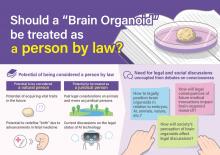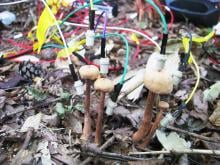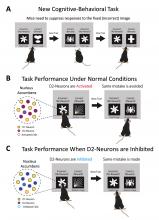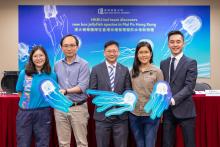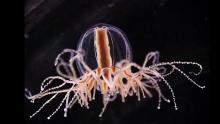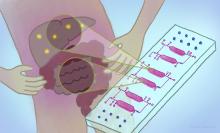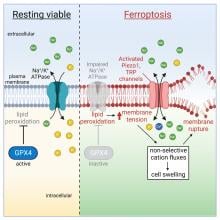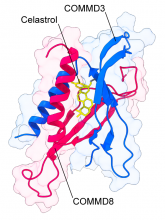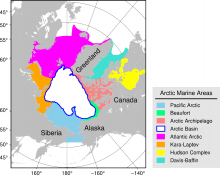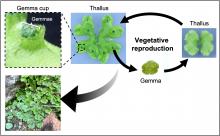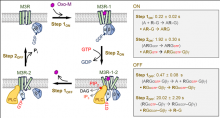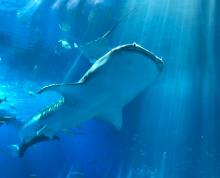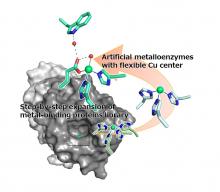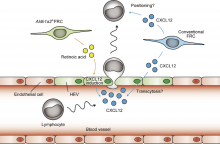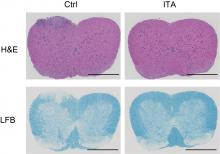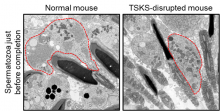Biology
News
28 Apr 2023
Certain types of fungi can communicate with each other via electrical signals. But much remains unknown about how and when they do so. A group of researchers recently headed to the forest to measure the electrical signals of Laccaria bicolor mushrooms, finding that their electrical signals increased following rainfall.
25 Apr 2023
The Nobel prize winning physicist Niels Bohr once said, “An expert is a (person) that has made all the mistakes that can be made in a narrow field.” This idea that to master a skill we must learn from our mistakes and avoid making them in future has long been recognized; however, the brain mechanisms and pathways that control this ability have been poorly understood.
We revealed a specific brain pathway that allows us to identify and learn from our mistakes to guide better decision-making in future.
Our work is an important step towards understanding how the brain controls our daily choices and behavior. The identification of these cells as ‘mistake signalers’ may also help to guide new treatments for mental health conditions associated with impaired decision-making ability.
18 Apr 2023
A Hong Kong Baptist University (HKBU)-led team has discovered a new species of box jellyfish in the Mai Po Nature Reserve in Hong Kong. The new jellyfish species, which belongs to the family Tripedaliidae, was named Tripedalia maipoensis by the research team. It is the first discovery of a new box jellyfish species from the waters of China. The discovery also adds a fourth species to the Tripedaliidae family.
14 Apr 2023
地球外生命が発見されれば、宇宙における私たちの存在意義に変化をもたらすだろう。しかしその探索に関する報道の在り方は、科学者やメディアにとって未だに大きな課題である。
13 Apr 2023
A research group at Osaka Metropolitan University has succeeded in selectively recovering trace rare earth elements in synthetic seawater and environmental water, such as hot spring water, using baker’s yeast with a phosphate group added. The phosphorylated yeast is expected to be utilized as a material for recovering useful metals and removing toxic metals, thereby contributing to the realization of a metal resource-circulating society.
11 Apr 2023
To survive, all organisms must regulate their appetite. Hormones and small proteins called neuropeptides perform this process, stimulating feelings of hunger and fullness. When researchers noted the similarities between GAWamide, a neuropeptide that regulates feeding in the Cladonema jellyfish, and myoinhibitory peptide, a neuropeptide that regulates feeding in fruit flies, they decided to test whether they could exchange the two. Their success in doing so highlights the deep evolutionary origins of feeding regulation.
10 Apr 2023
Nitrogen is such a crucial nutrient for plants that vast quantities of nitrogen-containing fertilizers are spread on farmlands worldwide. However, excess nitrogen in the soil and in drainage run-off into lakes and rivers causes serious ecological imbalances. A recent study has uncovered the regulatory mechanisms at work when plants utilize nitrogenous fertilizers in their roots, a positive step in the quest to generate crops that require less fertilizer while still producing the yields needed to feed the world.
10 Apr 2023
AI finds the first stars ✨were not alone, Auto-switch for large electronic devices, A metabolite against autoimmune diseases, & Converting fruit waste 🍊🍉into solar stills. Plus in our blog: A career worth doing, a life worth living. Read all in the latest Editor's Choice.
07 Apr 2023
A tiny platform empowers scientists to examine how gut and liver cells interact in health and disease.
05 Apr 2023
Ferroptosis is a recently discovered type of cell death associated with certain neurodegenerative, cardiovascular and kidney diseases. Whilst scientists have understood that accumulated iron and degenerated lipids trigger ferroptosis, the actual mechanisms at play have remained a mystery. A team of researchers from Tohoku University has identified where in the cells these accumulations take place, and what gets targeted as ferroptosis occurs.
05 Apr 2023
Researchers from Osaka University found that the COMMD3/8 complex is implicated in the progression of the autoimmune response in a mouse model of rheumatoid arthritis. They identified celastrol, the active compound of a medicinal herb, as an inhibitor of the COMMD3/8 complex. Celastrol blocked the progression of rheumatoid arthritis. Thus, celastrol is a potential lead for developing treatments against rheumatoid arthritis.
04 Apr 2023
Marine predators have expanded their ranges into the Arctic waters over the last twenty years, driven by climate change and associated increases in productivity.
31 Mar 2023
Asexual, or vegetative, reproduction in plants is controlled by environmental conditions, but the molecular signaling pathways that control this process are poorly understood. Recent research suggests that the KAI2-ligand (KL) hormone is responsible for initiating and terminating the production of gemmae, or genetically identical plantlets, on liverwort plants based on the presence or absence of specific environmental factors.
31 Mar 2023
- The effect of the cycle of G proteins in real time on the two-step structural change of cell membrane receptors has been investigated
- This study is expected to be applied to pathologies related to G protein-coupled receptors and on research for their treatments
31 Mar 2023
- DGIST Professor Minseok Kim’s research team has developed an electronic medicine that can restore normal Schwann cell phenotypes in CMT disease models
- It presents the potential of electric stimulation-based treatment for chronic peripheral nerve disorders
28 Mar 2023
A group including Osaka Metropolitan University researchers discovered that the rhodopsin—a protein in the eye that detects light—of whale sharks has changed to efficiently detect blue light, which penetrates deep-sea water easily. The amino acid substitutions–one of which is counterintuitively associated with congenital stationary night blindness in humans—aid in detecting the low levels of light in the deep-sea. Although these changes make the whale shark rhodopsin less thermally stable the deep-sea temperature, allows their rhodopsin to keep working. This suggests that the unique adaptation evolved to function in the low-light low-temperature environment where whale sharks live.
28 Mar 2023
A research group at Osaka Metropolitan University has succeeded in simply creating an artificial metalloenzyme with the common metal-binding motif 2-his-1-carboxylate, which is found in natural non-heme metalloenzymes. They created a library of 12 different proteins and screened the library and found that the H52A/H58E variant had the best stereoselectivity. It is expected that this research can be expanded to produce a variety of biocatalysts that work under mild conditions.
24 Mar 2023
Hailey-Hailey disease is a rare, inherited condition characterized by patches of blisters appearing mainly in the skin folds of the arm pits, groin and under the breasts. It is caused by a mutation in the gene that codes for a specific protein. Tohoku University scientists have uncovered some critical details of this protein’s structure, and the findings could build the foundation for developing treatment for Hailey-Hailey disease and other neurodegenerative conditions.
23 Mar 2023
Researchers from Osaka University identified a subset of fibroblastic reticular cells (FRCs) that simultaneously express two proteins, Aldh1a2 and Tie2, making them unique to areas of the omentum called milky spots. Genetic depletion of these cells caused structural disruption of milky spots. The FRCs were critical to the abdominal immune system as they regulated CXCL12 levels, a molecule necessary for lymphocyte recruitment from blood circulation. These insights can help develop novel treatments for intra-abdominal infections.
20 Mar 2023
Parasitic infections in salmonid fish can increase or decrease their vulnerability to angling, depending on their body condition.
18 Mar 2023
Scientists restore impaired kidney for the first time, How fibre composite fails when wet, Cleaner fish recognize themselves in pictures 🖼️🐟& The source of black carbon in the sea. Read all in the latest Editor's Choice. Plus our magazine Asia Research News 2023 is out now 🎉!
15 Mar 2023
Researchers have revealed the modulatory effect of the anti-inflammatory metabolite itaconate on T helper and T regulatory cells, which may lead to new therapeutic approaches to treating some autoimmune diseases.

13 Mar 2023
Researchers at Kanazawa University report in ACS Nano how high-speed atomic force microscopy can be used to study the biomolecular mechanisms underlying gene editing.
13 Mar 2023
Researchers from Osaka University identified the role of a protein known as testis-specific kinase substrate (TSKS) in the process of spermiation, the release of mature sperm. Analysis of a gene-modified mouse model in which TSKS is disrupted revealed that TSKS is necessary for sperm to eliminate cytoplasm and become streamlined. These findings may lead to the development of diagnostic tests and male contraceptives.
10 Mar 2023
Osaka Metropolitan University scientists successfully quantified the total reactive polysulfide content of 22 different types of vegetables, including onions and garlic. They also revealed that reactive polysulfides are not only found in the leek genus (Allium), such as onions and garlic but also in the cruciferous family of vegetables (Brassicaceae), such as broccoli and cabbage.
08 Mar 2023
Finding extra-terrestrial life would transform how we view our place in the Universe, but reporting on the search for it poses challenges for scientists and the media.
07 Mar 2023
Researchers in Sarawak, Malaysia, measured the immunity responses of people who received different COVID-19 vaccines.
04 Mar 2023
Scientists have shown that swarming molecular robots can deliver cargo five times more efficiently than a robot working on its own.
03 Mar 2023
Insights into their diversity will help to understand and protect them and their natural environment.
Events
Sorry, nothing coming up for this discipline
Researchers
Sorry, nothing coming up for this discipline
- « first
- ‹ previous
- 1
- 2
- 3
Giants in history
Sorry, nothing coming up for this discipline
- « first
- ‹ previous
- 1
- 2
- 3


